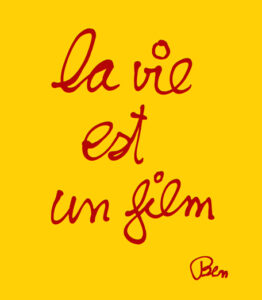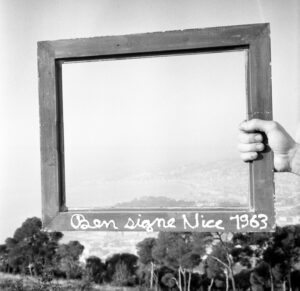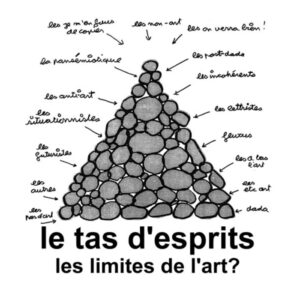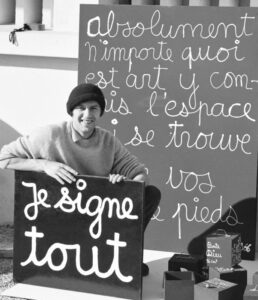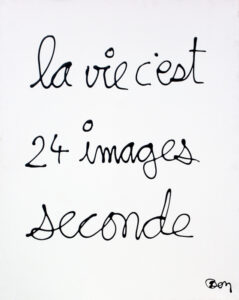[vc_row row_type=”row” use_row_as_full_screen_section=”no” type=”full_width” text_align=”left” background_animation=”none” css_animation=”” css=”.vc_custom_1563199941205{border-right-width: 5% !important;border-left-width: 5% !important;background-color: #f2f2f2 !important;}”][vc_column css=”.vc_custom_1563200038543{background-color: #f2f2f2 !important;border-radius: 1px !important;}”][vc_tabs style=”horizontal”][vc_tab title=”Life is a movie” tab_id=”c66a3b83-7899-5″][vc_column_text css=”.vc_custom_1563200272161{background-color: #ffffff !important;}”]
Exhibition “Life is a movie
Ben and his guests at 109
Exhibition from June 15 to October 19, 2019
Catalog “Life is a film” of the exhibition of Ben and his guests
Life is a movie catalog
Text Hélène Guenin and Elodie Antoine
Photography François Fernandez
200 pages, 28,5 x 24,5 cm
Editions: In Fine, 2019
35,00 Euros
Life is a movie…
To celebrate the centenary of the Victorine studios, the city of Nice is planning Nice 2019, the odyssey of cinema, a whole year of exhibitions and events to promote the history of cinema and current film production in Nice. The 109, on the site of the former slaughterhouses, route de Turin, is a place of extraordinary dimensions converted by the municipality into a center for contemporary creation.
Within this artistic breeding ground, the City of Nice and the artists’ collective La Station, with the support of Éva Vautier, invite Ben Vautier for a large summer exhibition entitled: Life is a film. More than 500 of Ben’s works, retracing 50 years of creation, will be installed in the large hall of more than 2,000 square meters, which he has chosen to share with guests, artists, long-time friends and young creators. This space in perpetual motion will host filmed productions, events, performances and debates, so dear to the artist.
A major artistic figure of the second half of the 20th century, Ben is known for his actions and paintings. His production, both philosophical and impertinent reflection on art, integrates our daily life in its most particular. Ethnism, ego and truth are also important issues in his work.
Ben’s story and his art are deeply rooted in Nice. He was fourteen years old when he moved to Nice with his mother. Ten years later, at the end of the 1950s, he opened a second-hand record store at 32 rue Tonduti de L’Escarène. He quickly transformed the facade by accumulating a quantity of objects. Ben’s store was born. This place of meetings and exhibitions became the meeting place for the main artists of the Nice School: Ben was convinced that “art must be new and bring a shock”. 1959 saw the creation of numerous performances, including “I sign life” and “Look at me, that’s enough” on the Promenade des Anglais. In 1963, he invited George Macunias to Nice for the first World Festival of Fluxus and Total Art in France. Historical actor of this movement, on this occasion, Ben signs Nice “open work of art” on the Mount Alban.
When the Magasin de Ben became part of the Permanent Collection of the Centre Georges-Pompidou in 1975, he transferred his activities to his home on the hill of Saint-Pancrace. Ben continues to organize exhibitions with Supports/Surfaces, the Figuration Libre and launches the first Pour ou contre debates.
Very involved in the contemporary scene, Ben has always supported young artists, encouraged encounters, and given his point of view on current events, initially through leaflets, posters and newspapers, today through rich and regular newsletters.
The event Nice 2019: The Cinema Odyssey, also resonates as a call to Ben’s important iconographic production. Camera in hand for 60 years, he has built up a considerable film collection, following the evolution of techniques, their supports and their uses. At the terraces of cafés or during artistic events, he captures moments, calls on many anonymous people and artists that he summons on the spot.
Several events will be organized during the exhibition with outdoor cinema screenings, performances, workshops and concerts.
Exhibition
Ben – Historical journey
The exhibition opens with a historical section presenting a selection of key works by Ben from 1958 to 1978. These testimonies trace the quest for a personal formal language that leads to the first writings. Initially simple signage, the posters produced in his store launch calls for meetings, encounters and exchanges. Backbone of the artistic community in Nice, the Magasin de Ben becomes the source of experimentation, gestures and actions, as well as the Promenade des Anglais, the street and the bistros. He thus begins street actions, in the line of the Fluxus movement, which he imports in France and of which he becomes one of the great protagonists.
At the end of the 1950s, Ben signed everything, appropriating the world as a whole through his images and actions. To illustrate these years, documents of the time are presented: posters, photographic archives and videos.
Research of forms / bananas and first writings (1955-1967)
When Ben began his artistic career in the mid-1950s, he experimented with all kinds of theories and practices with the primary goal of finding a personal formal language, of inventing something new, beyond the existing repertoire. As early as 1955, he retained the form, both abstract and phallic, of the banana, which he immediately declared to be his personal creation, and produced a whole series of drawings, on different supports, in Indian ink on paper.
From 1958 on, Ben discovered the potential of writing. Initially in his used record store, these are both information for visitors and advertising writings, such as “Le Bon Lait”, or even brands, such as Coca-Cola. The information panels are then made of wood and written with oil paint. Later, he developed his own technique, writing directly on the canvas, with a pipette filled with acrylic paint, tracing a new distinctive calligraphy. The signified takes over the signifier.
The Store (1958-1973)
The Magasin, a work by Ben currently housed at the Centre Georges-Pompidou, reflects the vitality of the record store, which also served as a meeting point for the Nice art scene, a gallery, an exhibition space and a venue for all types of performances.
In the 1950s, Ben’s store was not only the liveliest art space in the city but also the gallery with the widest range of artistic expression. Ben’s programming is open to novelties and experimentations, anchored on a regional network of artists. Ben’s store is one of the places carrying the School of Nice and from 1963, the starting point of many Fluxus actions, of which it becomes the headquarters.
Already at this time, Ben was interested in the theory of ethnism of François Fontan, of whom he would become one of the most fervent disciples. Once again, the Magasin is the place to be for the movement committed to linguistic and cultural minorities – an issue that, for Ben, has lost none of its relevance.
Fluxus
In 1962 in London, during the Festival of Misfits, Ben met Georges Maciunas, founder and central figure of Fluxus. More than a movement, Fluxus is a state of mind, a space of sharing, of friendship, in which dozens of artists of all nationalities will recognize themselves. They propose an experimental total art that brings together multiple artistic languages by their will to abolish the gap between art and life.
Invited to the Festival by Daniel Spoerri, Ben exhibits himself as a living sculpture for 15 days and nights in the window of Gallery One. The following year, as a continuation of this collaboration, Ben organized in Nice the last stage of a European tour, a World Festival of Fluxus and Total Art. He then founded a group in Nice, the Théâtre d’Art Total, declaring that theater is not on stage, but in the street, in life.
The actions of this group take place on the Promenade des Anglais and a concert is organized in the lounge of the Hotel Scribe. At the Théâtre de l’Artistique, Ben, Maciunas, Erébo and Serge III perform Fluxus pieces, including Paper Piece by Ben Patterson and Duo for Violin by La Monte Young.
For Ben, “everything is art” and he continues to keep the Fluxus spirit alive through his work.
Street gestures and actions (1958-1972)
In 1973, more than sixty of these actions were represented and materialized in a series of descriptive tables, like technical data sheets from the archives. Representation of these gestures, in words and images, they list a posteriori the actions in a coherent set dated from 1958 to 1972.
The meaning of the Gestures can be summed up in one: Look at me, that’s enough (1963-1965), as can be read on the sign with which Ben exposed himself on the Promenade des Anglais in Nice.
Ben – Contemporary course
Through a succession of themes, from his Small Ideas to New Writing, passing through Mirrors, Photography, Time or Death, Ben proposes a contemporary reading of his work. He continues his introspection in a journey through which the visitor is invited in turn to question his condition, his time, his society. Each new word, each new gesture is part of a quest for meaning and truth.
The signature (1958 – 2019)
“There is no art without a signature. One cannot enter the history of art without a signature and a date. There is no such thing as a collective work. There is always a detective to find out who made it and when. Even for the Lascaux caves, we start to track down the personality of the artist and we look for his signature. I said to myself then that if art was only a question of signature why not make a painting with just my signature; exhibited from 1958, just about everywhere.”
The crates (1960 – 2015)
“There is great art, which is in the museums and then on the street, there is the vegetable market. And in the vegetable market, there is the everyday life and in the museum, there is the artist who says: “I would like to exhibit the everyday life”. So I wrote on crates some sentences I heard at the market.
I also like the crate because it’s a free medium that you can find thrown away by the hundreds at the market. That’s my little cheap side.”
Time (1961 – 2019)
“Some people think money is very important. Others think it’s health. I think as John Cage once said: the important thing is the use of time. A billionaire, a dictator, a tramp all use time differently, but they only have 24 hours in a day. And it is the use they make of these 24 hours that is important. Time is a theme I started working on in 1976, although I signed Time in 1960.”
The poor collector (1989 – 2015)
“I insisted that this space exist because when I go to Abbé Pierre’s house and I see a painting that looks like Gauguin, Picasso, any other artist, I take it because it fits my art history because in art history, it’s style that counts and style is repetition.”
Portraits
“I always see two heads everywhere. You show me a pan and I see a head, two shoes on the floor, I see a head, it has even become a problem for me not to see them. I remember my mother saying: “The kid makes very good portraits”. It’s not true. Nevertheless, today I feel free to make heads. On the day of the opening I will be doing my self-portrait at 7:30 pm.”
Cinema section
Camera in hand Ben has built up a considerable filmic collection over a period of sixty years in which anonymous people and artists appear in everyday situations such as on the terrace of a café, during openings or happenings.
His first films archiving his street actions from the 60s, his conceptual films and also his latest creations are presented.
The first film : CANNES VILLE 1963
During the Cannes Film Festival in 1963, Ben put up posters on the walls of the city:
Ben, creator of total art, presents and signs his extraordinary film CANNES VILLE 1963 during the Festival.
To make this film, proposed to George Maciunas, Ben had to rent a cinema; to announce an avant-garde film; he would have installed his cameras, three if possible, hidden behind the screen or on the sides, in the curtains. These cameras would have filmed the empty room, then the public entering to sit down, the public getting impatient not to see the film start, the public, furious or not, asking for their money back, leaving the room little by little; the last image of the film and the first being the empty room.
THE NON FILM (2003)
This experimental film deals with the search for truth, life, ego and in general with what it means to make a true film. He reveals the functioning of his reflection in the realization of his work, the atmosphere and the presence of his entourage in a succession of funny, sensitive, provocative and intimate sequences.
Guest artists
As he has always made a point of doing, Ben invites artists, historical or emerging, locally or internationally recognized, recent acquaintances or long-time friends, met along the way. It offers them a space in the hall to present their works, projections, performances or poems.
Antaki, Arman, Helios Azoulay, Michel Batlle, Ruy Blas, Robert Bozzi, BP, Jean-Pierre Bruno, John Cage, Denis Castagnou, Denis Castellas, Jacques Charlier, Giuseppe Chiari, Albert Chubac, Philip Corner,Béatrice Cussol, Daniel Daligand, Raymond Denis, Charles Dreyfus, Marcel Duchamp, Joël Ducorroy, Robert Erébo, Robert Filliou, Gregory Forstner, Joëlle Gainon, Alexandra Guillot, François Guinochet, Jacques Halbert, Max Horde, Isidore Isou, Pascal Josse, Konny, Maurice Lemaître, Jacques Lizène, Serge Maccaferri, Jonier Marin, MissTic, Olivier Mosset, Bernard Pagès, Francois Paris, Philippe Parreno, Bruno Pelassy, Presence Panchounette, Philippe Perrin, Jacques Pineau, Nicolas Private, Maxime Puglisi, Johnson Ray, Robert Roux, Serge III, Bernard Taride, Cédric Teisseire, Bernard Venet, Jean-Luc Verna, Ultra Violet….
Ben has always favored meetings, confrontations, debates and creation. From 1965, in the mezzanine of his store, the Ben gallery doubts everything, he exhibits all the artists who interest him: Boltanski, Sarkis, La Monte Young, Alocco, Venet … In 1972, he opened La fenêtre, where he presented the avant-garde of Nice. In 1975, he organizes at his home in Saint-Pancrace the Pour ou contre, during which he animates debates and exhibits in particular Supports/Surfaces, Figuration Libre, Fluxus, Arman, Daniel Spoerri, Gilli and Serge III. In 1999, he opened consecutively in Nice the Centre du Monde, rue du Lycée, followed in 2011 by the Espace à débattre, rue Vernier, and in 2017 Le César, in Old Nice.
He is also at the origin of large group exhibitions. In 1977, À propos de Nice represents the whole of the new artistic creation of Nice for the opening of the Centre Georges-Pompidou in Paris. In 1983, he organized an exhibition of the young creation of the south on the quays of the former railway station of Provence, One artist can hide another. In 2003, Fluxus Nice brings together the international and French Fluxus movement in different places with theater, exhibitions, performances, conferences and concerts. He did it again in 2006 with Le tas d’esprits in Paris, rue de Seine. In 2016, it is the ideal Palace of the Facteur Cheval in Hauterives which receives its guests.
Debate section
In 1958, one day, on the Promenade des Anglais in Nice, Ben met François Fontan. Both of them love discussion and debates and meet every night to discuss life, sex, people, international politics, cultures, languages, ethnicities. All are welcome to participate in the discussions. We talk about the ideas of Wilhelm Reich, Marx, Freud, etc. François Fontan’s position: the political future of the world is not in uniformity but in diversity.
In 1974, the first debates in Saint-Pancrace, on the lawn of Malabar and Cunégonde’s house, were animated during the For or Against events. There is a microphone, a big table, a buffet and we discuss until late in the night. Some come for the speech, others for the merguez. Among these pros and cons, we remember Arman’s Tas, the discussion with Combas and Di Rosa, Olivier Mosset’s exhibition and his noisy arrival with 80 bikers from the Bastille and the spat between Martine Doytier and Noël Dolla.Cultivating this tradition, Ben has set up a space in the big hall of the 109, with several sofas, carpets on the floor, a table to put glasses on, a big white board with markers, a microphone, music, books and when he is there, he will launch a debate and invite the public to participate.
Performance section
For this exhibition, Ben installs a boxing ring, as he did in 1972 during his exhibition at Documenta 5 in Kassel, Germany. It was in this ring that Joseph Beuys, as part of a farewell action, participated in a boxing match with the art student Abraham David Christian. In 2012, for the 50th anniversary of the Fluxus movement, Eric Mangion, director of the Villa Arson art center, invited Ben to renew the installation and organize performances on this ring for the exhibition Ben signs Nice. The artists follow each other in rounds of 3 minutes 33 seconds, the time imposed to execute their performance. Dance, body expression, music, theater, parades and of course Fluxus pieces follow one another joyfully. Each action, carried out in public, is filmed and then transmitted in deferred on a screen placed in the center of the installation. The performances took place over several weeks, every Wednesday at 6:33 pm. Ben presents himself as conductor and referee, thus rediscovering the basics of the Fluxus movement.
In 2013, with the city of Blois, Ben opened the Fondation du Doute. The ring becomes a space for the Combat of Ideas, for the inaugural exhibition of this new art center, which presents a collection of over 300 Fluxus works.
This ring returns to the Great Hall, in the heart of the space, around a program of performances, thus placing expression and ideas at the center of the life of the exhibition, in the tradition of Fluxus which proclaims that art is life.
Biography
Ben is one of the major artists of the 20th century known for his actions and paintings. His production, at the same time reflection on art in its most fundamental and integrating our daily life in its most particular, succeeds in making life an art. Thus entered in his work universes as far from artistic Duchamp as the ethnism, the ego or the truth. Ben enjoys an incredible popularity thanks to his writing, which combines the greatest impertinence and the greatest accuracy.
Ben, whose real name is Benjamin Vautier, is a French artist of Swiss origin. Born on July 18, 1935 in Naples, of an Irish and Occitan mother and a French-speaking Swiss father, he is the grandson of Marc Louis Benjamin Vautier, a Swiss painter of the 19th century. He lived his first five years in Naples. After the declaration of war in 1939, Ben and his mother travelled extensively: Switzerland, Turkey, Egypt, Italy, and finally settled in Nice in 1949. He studied at the Parc-Impérial school and at the Stanislas College boarding school. His mother finds him a job at the bookstore Le Nain Bleu as an errand boy, then buys him a bookstore.
At the end of the 1950s, he sold it to open a small store, transforming its facade by accumulating a lot of objects and in which he sold second-hand records. His store quickly became a place for meetings and exhibitions where the main members of what would become the Ecole de Nice met: César, Arman, Martial Raysse, etc. Close to Yves Klein and seduced by the New Realism, he is convinced that “art must be new and bring a shock”. At the beginning of the 1960s, the game of appropriations began. The rule established by Yves Klein was to appropriate and sign the world as a work of art without ever copying and always being the first. Duchamp had the rags, Christo the packaging, Arman the Accumulations, Klein the Monochrome, Ben is going to sign everything that wasn’t: the holes, the mysterious boxes, Nice, the kicks, God, the chickens, etc., linking art and life, explaining that everything is art and that everything is possible in art Essentially, Ben is a conceptual artist, an artist of ideas. He is a provocateur, a scoffer, an iconoclast, he is unclassifiable.
“Ben’s Gestures, which he began performing in the late 1950s, now have their place in the pantheon of performance art. His Writings are radical, revolutionary works. His works on social attitudes and conditions reveal a great humanism. Ben has an inexhaustible energy, which produces a stream of information, opinions, books, essays and internet material. He is not the cliché artist locked in his ivory tower but rather a street artist.” Jon Hendricks, 2010.
Ben lives and works since 1975 on the heights of Saint-Pancrace, a hill in Nice. His work is represented in the world’s most important private and public collections, including the Museum of Modern Art in New York, the WalkerArt Center in Minneapolis, the Art Gallery of New South Wales in Sydney, the Museum ModernerKunst Stiftung Ludwig in Vienna, the MUHKA in Antwerp, the Stedelijk Museum in Amsterdam, the Museum of Solothurn, the Centre Georges Pompidou and the Musée National d’Art Moderne in Paris, as well as the Musée d’Art Moderne et d’Art Contemporain in Nice.
Ben, by Bernard Blistène
Director of the Musée national d’art moderne, Centre Georges-Pompidou
The era is amnesiac. It celebrates over and over again those who “perform”, a way of letting people believe that they are thwarting the system. No longer an exhibition without the presence of the body. No project without a multidisciplinary dimension. No longer a manifestation without reconciliation of opposites. Art is everywhere and each appointment is there to prove it.
The dissensus sinks into complacent representations. We stage the misfortunes of the world with the idea of being witnesses and accusers. The good conscience does its work and the trick is done.
Ben Vautier sees the world differently. Sixty years he has been calling us out and sending us back to our vain vanities. For sixty years, he has been fencing and expressing himself, struggling and flaring up in a jumble mixing tragedy and farce, suffering and joy, pros and cons. Praise for the difficulty of being oneself, self-criticism of the ego, aphorisms of all kinds. Ben is there, between truth and lies, between impertinence and wisdom. Ben is a necessary artist.
From the end of the 1950s to today, Ben stages and stages himself in the heart of a world that he never stops saying scares and amuses him. Ben rants and raves. He writes and he apostrophizes. He gesticulates and talks loudly. He is a scholar and a popular person. Ben is without a doubt one of the most extraordinary human animals I’ve ever been around.
From all this, from this daily fight against himself and the time that never ceases to pass, Ben makes a work like no other, a work recognizable among all. Familiar and inventive. A work that resembles him and in which everyone, one day in his life, has recognized himself and found himself. We all have something of Ben Vautier in us, so much Ben Vautier tells us something of ourselves, of our misery and our joys, of our fears and our vanities, of our desires and our failures. In short, Ben is the man in search of the truth, without doubt a moralist. Never a moralizer.
You have to look at Ben’s work again and again. It is necessary to follow the course and the metamorphoses. You have to see him trying to build his language. “I would draw shapes that I would throw away if I found their source of influence,” he writes of his early work. It is necessary to hear it seek “a beginning of personality” when appears in 1957, the shape of the Banana. And then come the Lines, the Stains, the Object Sculptures, the Hanging Objects, the Vomit, the Unbalance, the Holes, the Living Sculptures, the Lack and the All… The Whole as the search for reality in its totality, the Whole so that nothing escapes him. Between decoy and mastery. No doubt a superb definition of creation.
Because Ben is a creator. The word seems to be overused and suits him well. A creator who exposes, signs and sells God, his rival, at any price. A creator who runs and does justice to the Wasteland. A creator who gives form to words and invents, as his friend Jon Hendricks says on the occasion of Ben’s full striptease, a word painting. And then, there are the Gestures which, beyond the Actions – or “Aktion”, if you want to make Germanic and learned – beyond the “Performances” and other “Happenings”, of George Brecht’s “Events” with which they maintain a tender affinity, are the very expression of the life in all its states, of the body in all its manifestations: “Bumping my head against a wall”, “Spitting”, “Shining other people’s shoes”, “Digging a hole and selling earth”, “Urinating”, “Going into the water fully clothed with an umbrella”, “Painting myself”, “Beating myself”… And so on and so forth. To say everything, to do everything, never to stop, never to rest. The body, his body, mine, yours in all its states to never stop fighting against the inevitable. Well, never offside. Ben, “our contemporary”, in the absolute urgency to be and to leave traces. To never disappear.
Bernard Blistène, 2018
[/vc_column_text][/vc_tab][vc_tab title=”Exhibition photographs” tab_id=”38f01c0f-b567-0″][vc_gallery interval=”3″ images=”79405,79403,79401,79399,79407,79409,79411,79413,79415,79417,79419,79421″ img_size=”large” css=”.vc_custom_1563200174907{background-color: #f2f2f2 !important;border-radius: 2px !important;}”][/vc_tab][/vc_tabs][/vc_column][/vc_row]

